Key takeaways
- Only 35% of the projects worldwide are successful.
- The goal of the discovery phase is to prove your assumptions about the software project.
- The core of the discovery team usually consists of a business analyst, UX designer, project manager, and software architect.
- Skipping the discovery phase results in scope creep, failed deadlines, budget overrun, and falling out of product-market fit, leading to project failure.
- The discovery phase takes 2 to 6 weeks and consists of six steps: planning, business goal definition, customer journey mapping, UX concept creation, development guidelines creation, and project finalization.
Large IT projects run 45% over budget and 7% over time while delivering 56% less value than predicted, states McKinsey research.
Only 34% of organizations report they complete projects on time and on budget.
Can shifting focus toward the project discovery phase help? Let’s figure that out.
What is the discovery phase of a software development project?
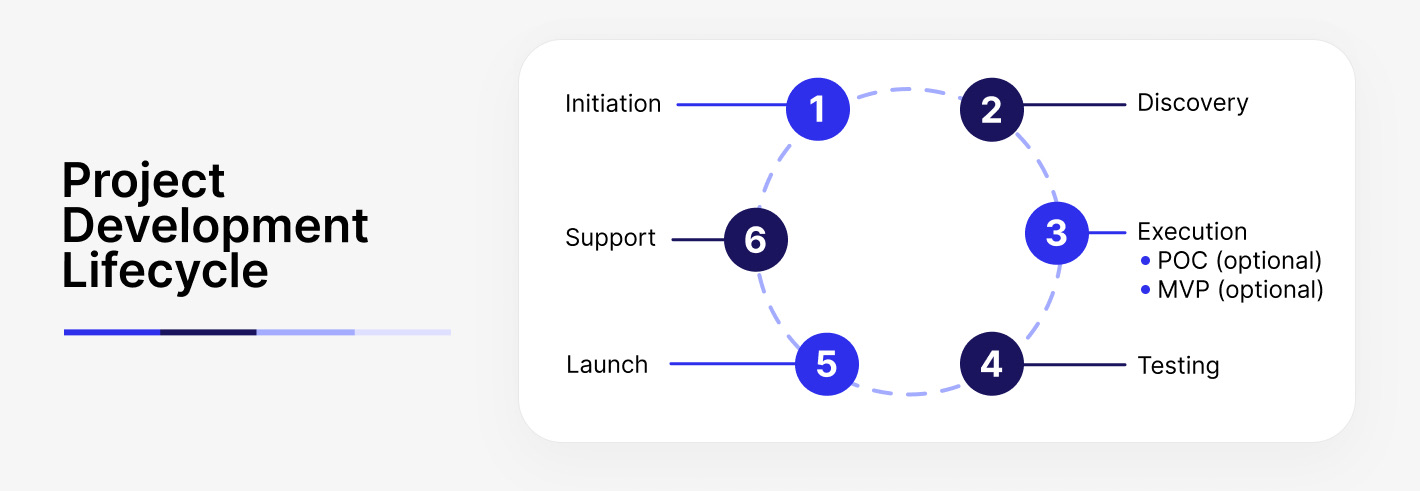
Software project development lifecycle
The discovery phase is an intensive exploratory process that precedes project development. Also known as the scoping stage, it aims to define project goals, scope, and limitations.
The main goal of the discovery phase in a software development project is to eliminate doubts and get a clear vision of the project.
In this article, we’re going to explore the ways the discovery stage is beneficial for your software project development.
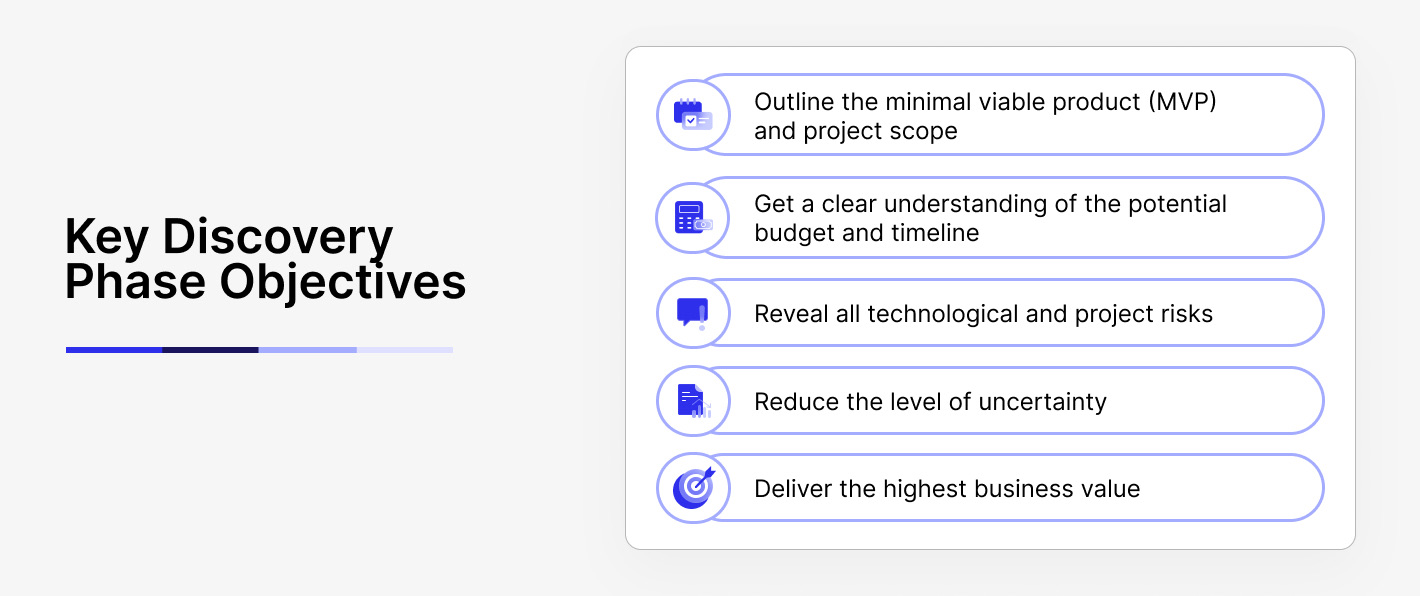


Key discovery phase objectives
The importance of the project discovery phase
Whether you are a startup or an established business looking to optimize your processes, the discovery phase is a must.
Benefits of project discovery
- Data-driven decisions. Plenty of decisions have to be made during the software development process. According to Paweł Pawłowski, a Chief Solution Architect at Arch Forge Solutions and RedPay CEO, there are three crucial areas for early decisions in software projects. They are goal definition, functional design, and architecture design. The discovery phase helps you back those crucial decisions with relevant, custom data.
- Trusting relationships. Regular communication during the discovery phase improves its effectiveness. It also establishes trustworthy relationships between the client and the IT vendor. At Sombra, we turn meetings into tools to ensure we stay on the same page with our clients. Those typically are introductory sessions, discovery workshops, demo sessions, and final presentations.
- Reduced risks. The Harvard Business Review reports, only 35% of the projects worldwide are successful. During the discovery phase, you can set clear goals, deadlines, and budgets for the project. Thus, minimizing the chances of a project failure.



Discovery phase benefits
Skipping the discovery phase in project management
Initiating the software development process without IT discovery can result in:
- Scope creep. Without a detailed action plan, new requirements will be mushrooming endlessly.
- Missed deadlines. Unforeseen limitations and endlessly growing scope lead to missed deadlines and increased time-to-market.
- Bloated budget. Numerous change requests increase project expenses. You will run out of your budget before the MVP is created.
- Falling out of product-market fit. Project scoping also enables you to test the alignment between your idea and market trends to assess your product potential in the wild.
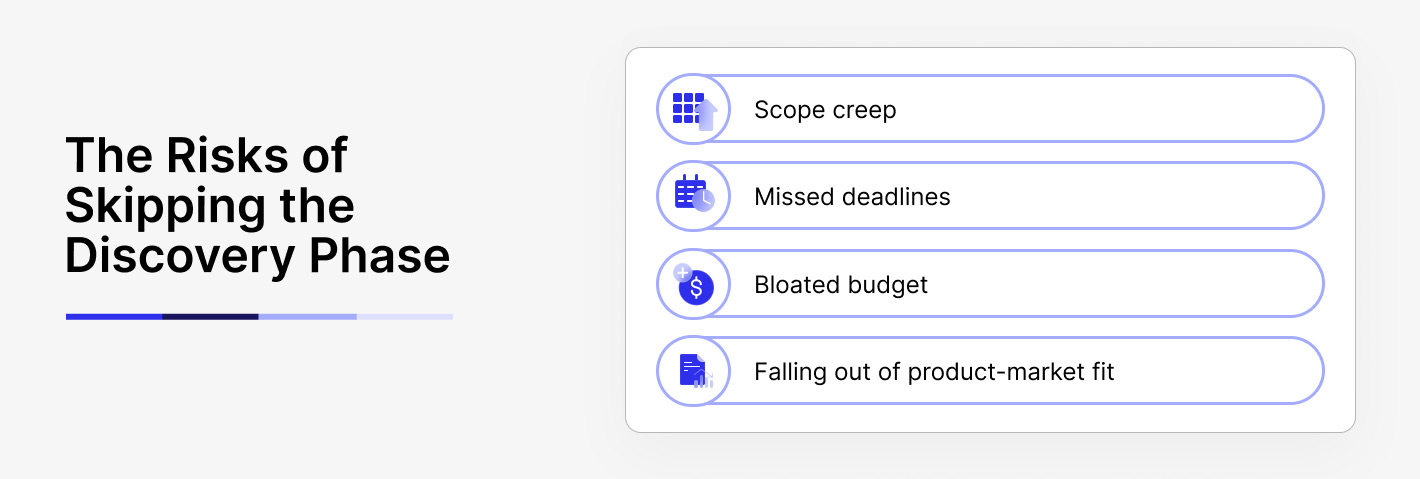


Risks of skipping the discovery phase
While the importance of the scoping stage of the project is undeniable, there are cases when it is ok to skip it:
- Cost estimation may be enough to start the development process. In this case, you have to have all the necessary documents, like the UX/UI concept, detailed product backlog, and architecture concepts.
- You might need to run a certain step of the discovery phase. For example, one of our clients approached us to migrate their existing product to new technology. Yet, they wanted to preserve design and all functions. We elaborated on a new architecture, estimated the budget and time frames, and proceeded with the development.
So, how do you determine whether you really need a discovery phase? Our Head of BA, Mariana Bandrovska, explains the top 5 reasons for conducting a discovery phase of a project.
How do we run the discovery phase of a project?
At Sombra, we treat the discovery phase as a project. It is a part of our IT consulting service.
Who is involved in the project discovery phase?
Typically, four specialists are involved in the discovery project management.
- Business analyst, who defines what the solution should be to solve a problem end-users care about. The BA collects, structures, and analyzes the client’s requirements and business needs. Then, transform those into user stories and estimates. Besides, the business analyst ensures that the client and the delivery team stay on the same page on project goals.
- UX designer, who does competitive analysis and researches end-users’ needs. This data is critical for building intuitive and visually-appealing user experiences. They create prototypes and wireframes to bring the product vision to life. Also, the UX designer gives clear estimates of each stage of the UX/UI design development process.
- Software architect, who manages the technical side of things. Based on the business logic, they design the product architecture and define the tech stack. The software architect ensures the project is feasible in terms of development.
- Project manager, prepares a project plan, establishes internal communication, and evaluates and manages the risks. The PM also gathers estimates and adds them to the timeline.
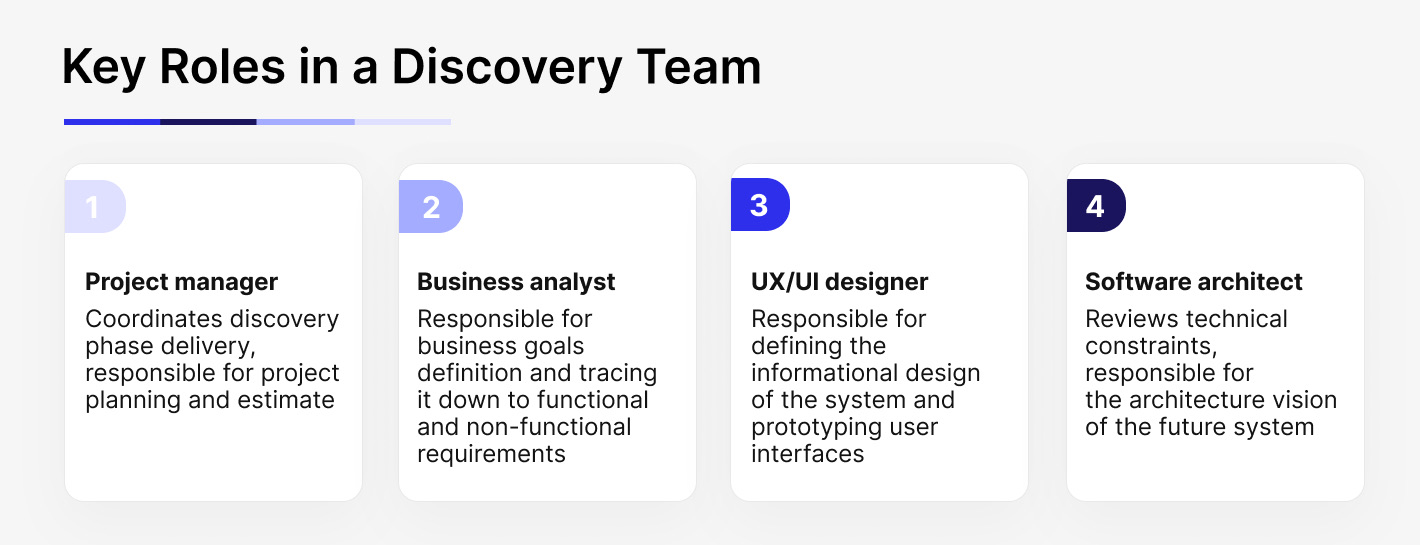


Discovery team composition
Your project might be more demanding and require additional expertise, which is fine.
At Sombra, we are very responsive to our clients’ needs and will bring in subject matter experts for consulting. It might be CTO, delivery managers, engineers, or tech leads working on similar projects.
What are the discovery phase steps?
The discovery phase of a project consists of the following steps:
Step 1: Discovery planning
During the discovery planning, we focus on getting as much information as possible. That is why we will send you a list of questions that will help us to prepare for the further steps.
Here’s an example of such questions:
- What is your current state, and what future state do you expect to get (achieve)?
- What business needs /problems/requests do you have?
- What business goals do you expect to achieve?
- Do you have any strict deadlines? What is the reason for it?
- How do you cover your needs now?
- Are there any business/tech constraints that we should be aware of (for example brand book, accessibility, language, DB…)?
- Who are your users (B2B, B2C, internal system)?
The main task of the discovery in projects is to determine the objectives we’re working for.
Step 2: Business goal definition
This step includes the identification of the stakeholders, and clarification of the project’s needs, expectations, and challenges. You would also need to define high-level specifications regarding the end goals and the core functions.
Step 3: Customer journey mapping
The design team visualizes the customer journey and business process mapping. It makes sure there are no gaps in the customer experience and that it is seamless across all touch points with the software.
Step 4: UX concepts and wireframes creation
Based on the research and the customer journey map, our team creates interactive prototypes ready to be tested out by real users.
Step 5: Development guidelines creation
Software architect designs software architecture based on deliverables from previous stages. It will include architecture diagrams, API endpoint designs, and component diagrams.
Step 6: Project finalization
You will receive a complete set of documents containing the deliverables from the discovery phase. These include a development proposal, UI/UX prototype, architecture concept, and product requirements.
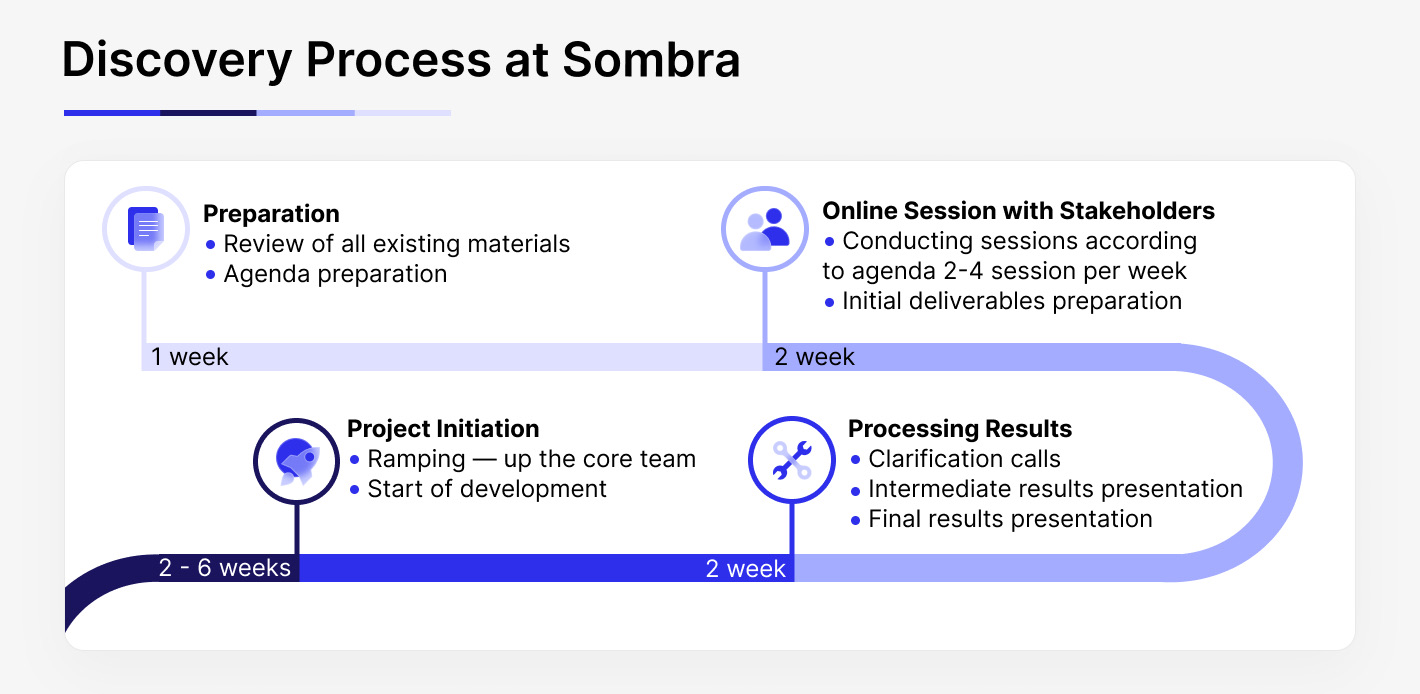


Discovery phase with Sombra
There are four types of such discovery meetings:
- Introductory session. At the inaugural rendezvous, we acquaint you with our dynamic discovery team. Here, you can confidently unveil your visionary project idea and share all essential details. After this, we shall outline the next strategic steps to propel your IT aspirations forward. Our next steps would be:
-
- choosing communication channels,
- elaborating the action plan for meetings,
- defining the success metrics,
- identifying expected deliverables.
- Discovery workshops. We will have a series of workshops during which we’ll report on the discovery phase progress and collect more information from you, if necessary.
- Demo sessions. We’ll validate the discovery phase deliverables against your expectations during these meetings.
- Presentation. It’s the final meeting, during which we’ll share all our deliverables. You’ll have the opportunity to review them and submit change requests within the agreed-upon timeframe.
The duration of each elicitation meeting differs. From our experience, it shouldn’t take longer than 90 minutes. Such discovery sessions proved to be counterproductive when taking too long.
Overall, the discovery project management takes around 6 weeks. The length of the scoping stage depends on the project’s complexity and the level of the IT vendor’s expertise.
What are the deliverables of a discovery phase of a project?
The discovery phase typically yields several key deliverables that serve as valuable outputs for the project.
Architecture vision
- General architecture scheme
- Technological requirements
- Integrations
- Architecture description
Software requirement specifications (SRS)
- Use cases or user stories covering functionality and its priorities
- Non-functional requirement
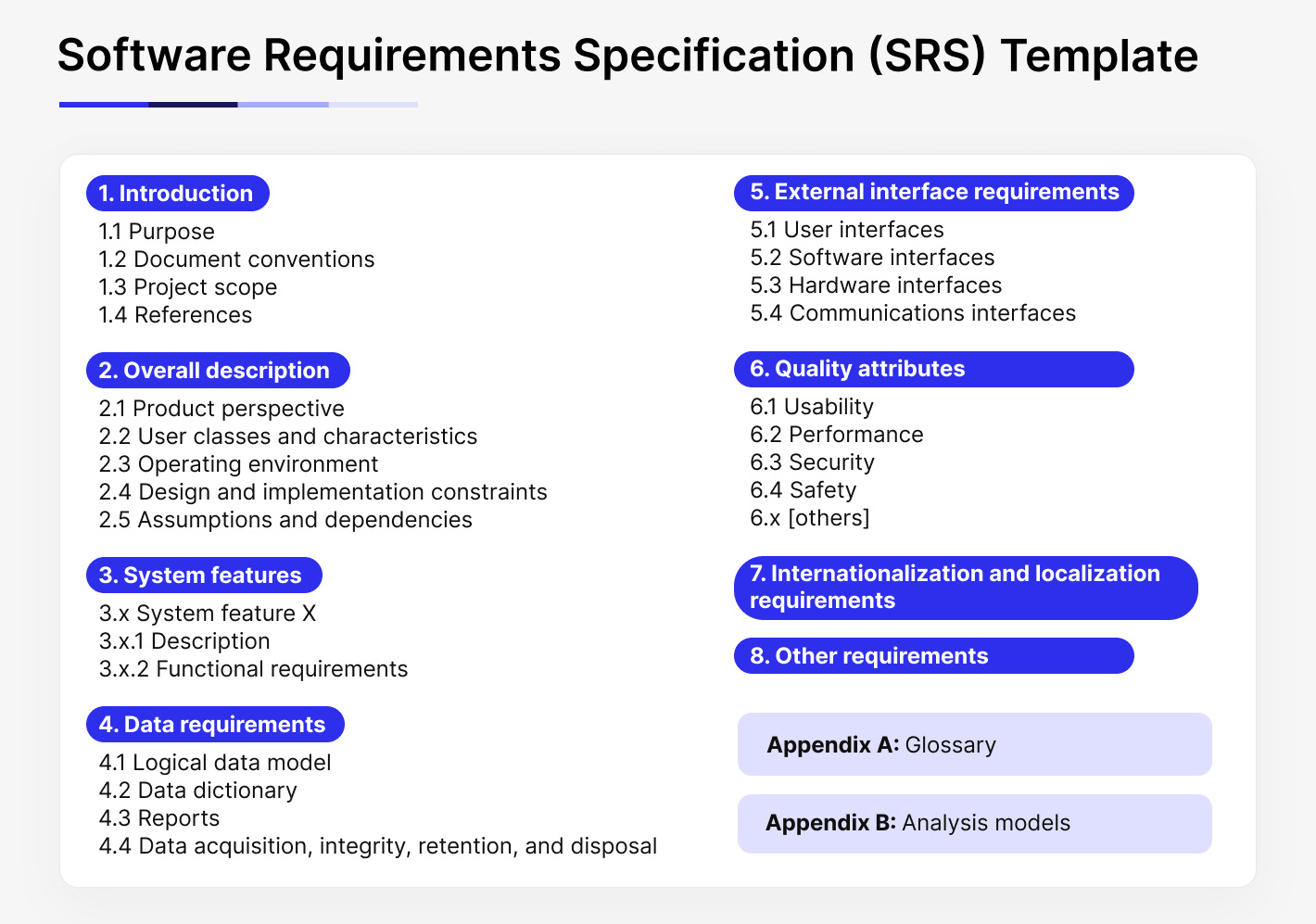


SRS template
UX deliverables
- UX concept
- Information architecture.
Proposal
A package that provides our suggestion on:
- Development approach
- Engagement model
- Team composition
- Timeline budget forecasts



Discovery phase deliverables
All these deliverables are vital, each deriving from the previous one. Together, they will give you a full understanding of what you need to achieve, how will the final product look, and the resources it requires.
It’s up to you to decide how to use them. For example, they can be a basis for further development (with us, any other software development vendor, or your internal team.)
What comes after the discovery phase of a project?
Project execution typically follows the discovery stage. The proposal package will dictate what happens next: PoC (Proof of Concept), MVP (Minimum Viable Product) development, actual product development, or none of that.
Our client, one of the leading call tracker software providers, faced the challenge of connecting their call tracking app to external CRM. Such a connection would have empowered the client’s call-tracking analytics.
We came up with a possible solution and performed a discovery phase, followed by a proof of concept process.
Our scope of work for the discovery phase included:
- Existing architecture assessment
- User and data flow investigation
- Design architecture assessment
- Investigation of the CRM’s capabilities for widget installations
- Low-fidelity prototype, which became the basis for the PoC
In three weeks we presented this client with the following deliverables:
- Product vision and scope document
- Project cost and timeline estimations
- Software architecture proposal with technical suggestions
- Data architecture scheme
- User flow schemes
- Technical solutions for widget installations for the CRM
- Interactive low-fidelity prototype
Based on the received outputs, the client was able to move on to the MVP development.
As a custom software development company, we can guide your project beyond the discovery phase. We can perform PoC (Proof of Concept) and assist you with building an MVP (Minimum Viable Product). In case you’re already past the project execution phase; we offer managed team and staff augmentation services to accelerate your project reaching new heights.
Contact us to discover how we can help you address your current business challenges.
Final thoughts
A successful discovery phase gives your project’s idea a solid base for further development. It helps you keep the development process aligned with your business needs.
The main goal of the discovery phase in a software development project is to eliminate doubts and get a clear vision of the project through:
- identifying project scope more accurately,
- defining team composition,
- optimizing the budget of the project,
- making data-driven design decisions,
- creating a seamless user experience,
- building a solid foundation for a higher ROI,
- identifying the direction of the development process and avoiding unexpected scope creep,
- identifying limitations and potential risks,
- building trust with the development vendor.
Implementing the discovery phase into IT project management helps to reduce its chances of failure. Contrary, it gives a solid base for further project execution and launch.











